A food futurist and keynote speaker is someone who analyzes current trends and innovations to anticipate where the field (and beverage industry) is headed. But what type of work services do thought leaders in the space generally perform? Turning to our team of food futurists and keynote speakers, here’s a brief overview of what a practitioner does…
- Research – Closely follows advances in food science, sustainable agriculture, nutrition science, food tech, biotechnology, packaging innovations and more.
- Trend Forecasting – Identifies emerging food and drink trends by analyzing consumer behaviors, startup activity, ingredient breakthroughs, demographic shifts and other factors shaping the industry. A top task for food futurists.
- Concept Development – Creates ideas and concepts for new food and beverage products, experiences, brands, and business models based on their understanding of where the market is heading.
- Strategic Consulting – Advises food and beverage companies, retailers, restaurants on product development, operations and investment decisions to align with future market forces and consumer values. Also commonly asked of food futurists and keynote speakers today.
- Consumer Insights – Leverages consumer surveys, focus groups, preference studies and data analysis to derive insights on eating habits, attitudes and unmet needs.
- Prototyping – Develops prototypes of new foods, packaging, and culinary concepts to demonstrate ideas in tangible ways and conduct consumer testing.
- Thought Leadership – Publishes reports, delivers keynote speeches, and engages in media commentary to inform and inspire industry stakeholders.
Put simply, working in the field of food futurists and keynote speakers, you’re looking to help food system stakeholders understand future possibilities, prepare for change, capitalize on innovation, and meet evolving consumer demands.

